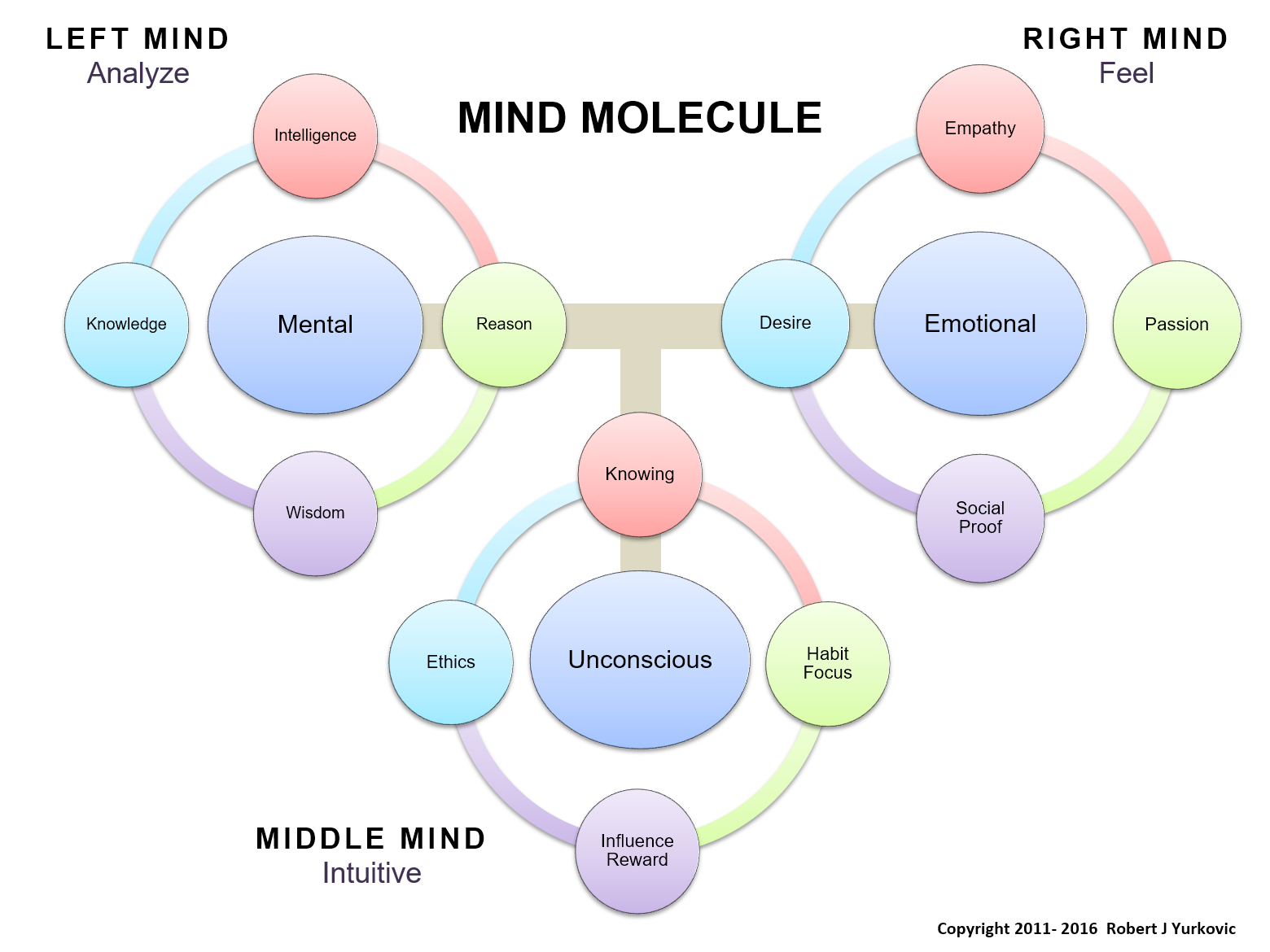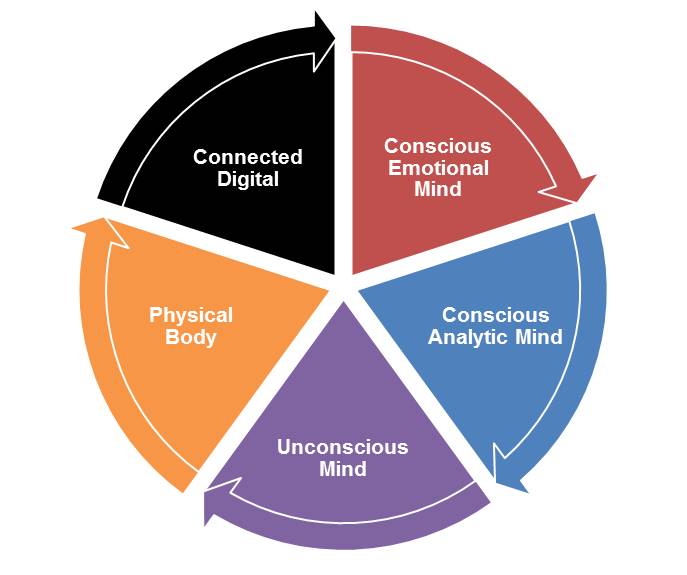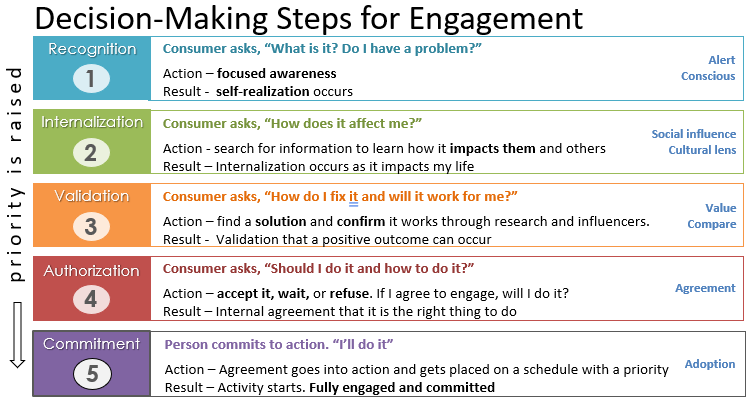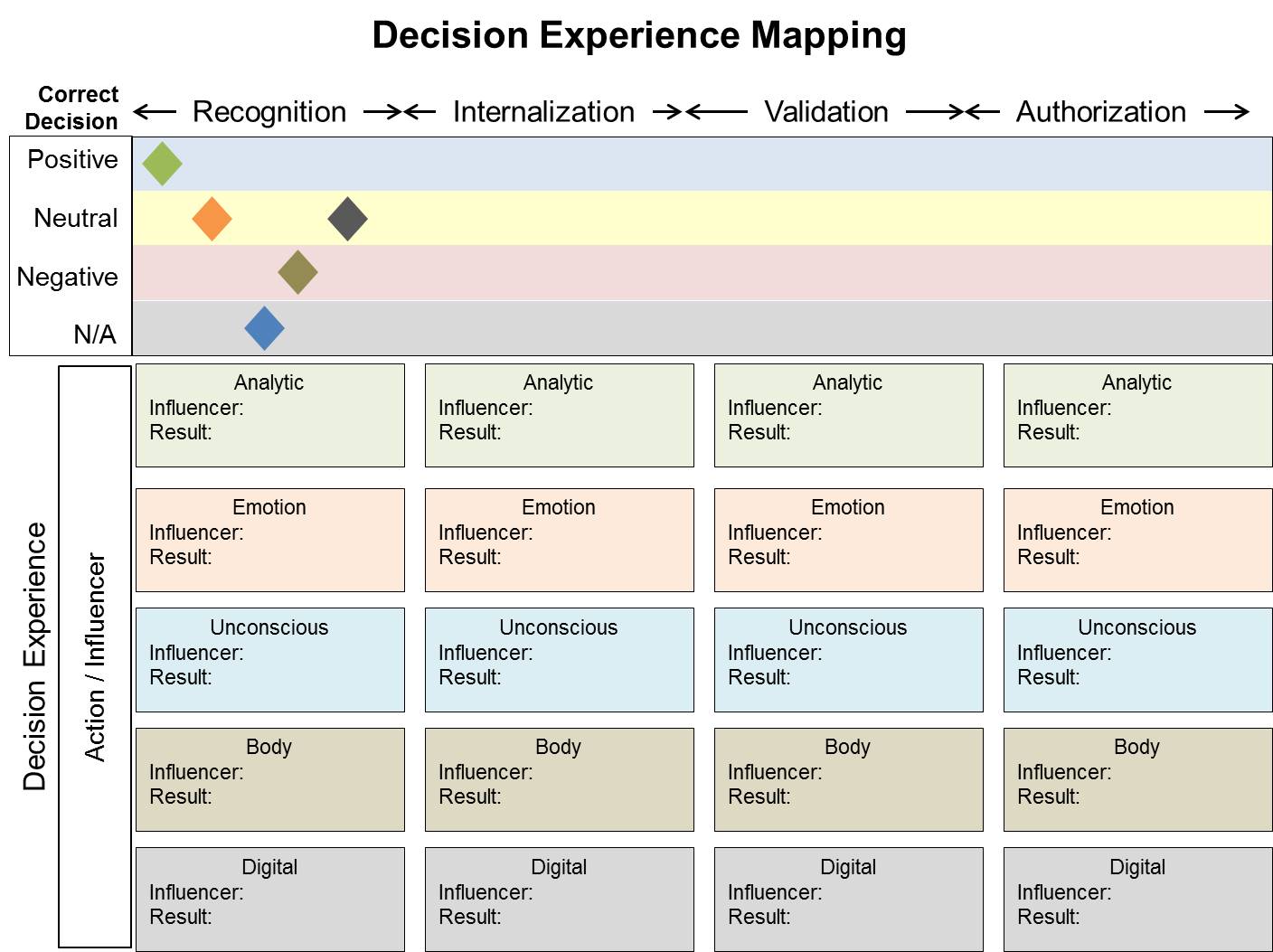By Robert Yurkovic
April 15, 2016
Many businesses are focusing on customer experience, user experience, education, and incentives to engage people in healthy living for a healthier population. People are motivated by different things and we find that decisions play an important role in how people engage in healthy behavior. By focusing on how people make decisions, we engage them in a sustainable and meaningful ways.
Real engagement in health care is about constantly making good decisions that affects our health. For sustainable good health, the key word is constantly. In the HealthScape of things, it is a war out there and we are the victims. Supermarkets are loaded with bombs disguised as processed food. Physicians hand out meds at the end of each session because we expect to get something for the visit. If we do not receive our adult version of a goody bag, we feel unrewarded. Marketing has us confused with inconsistent, irrelevant labeling so we are not sure what to buy even though the product is labeled natural and good for you. Our day is loaded with stress and is compressed with work deadlines, family issues, and too many things to do and focus on. How can we focus on our health and stay focused? We need to understand how we make decisions on a daily basis and understand that we live around a stream of decisions that shapes what we do. I call the constant processing in our minds a decision stream, which is made up of micro-decisions, mini-decisions, and macro-decisions. If a person wants to do something, they have to make a decision to do it and if it is not in our crowded decision stream, it does not get done.
Engaging people to lead healthy lives is not about thrusting an informative paper or web page in our faces on how to sleep, what to eat, how to manage stress, work life balance, and what exercises you must do every day. A push strategy has shown little success and so we need to look inside of ourselves to see what makes us tick or, more simply put, how we make decisions on what we do and how we live. If we can influence decisions and gain entry into a person’s decision stream, we have a chance to obtain sustained engagement.
As human beings, we make decisions based on fact, fiction, and hearsay. We are easily influenced from a variety of sources and internal mechanisms. It is my theory that constant decisions form the basis for sustainable consumer engagement in healthcare so if we wish to achieve sustainable engagement, we must influence decision-making. I always thought of the mind as a balance of analytic and emotion components with emotional components having the greatest decision-making power. But I have learned there is much more to it, such as the unconscious mind, which influences our behaviors in subtle, but powerful ways. This increases the complexity of decision-making and makes engagement more difficult to understand. So far, I have identified five key decision-making influencers and am surprised to find that the analytic component does not have a major effect on decision-making in normal everyday life until the moment we are thrust into making difficult decisions due to an adverse event or situation.
In my recent book, “Commercializing Consumer Engagement”, I created a quote to set the tone for the material. In 2014, I said, “Human are extraordinary beings that rise to face adversity but need adversity to be able to rise.” We are truly motivated to make good decisions and act accordingly when placed in a position of adversity. In other words, we tend to eat the right foods just after we had a heart attack or reduce our sugar intake after we learned we have diabetes type II. But when things are good, we tend to relax on our decision-making expertise which often lead to experiences that are less than optimal.
I understand the meaning of the following saying, “Live life like it is the last day of your life.” If we believe we would die tomorrow, our decisions are more analytic in nature and lead to better outcomes. Mortality has a way to motivate us in making good life decisions. The question is, why wait until something goes wrong to make healthy decisions? Why not influence our decision-making now and achieve and maintain a healthy lifestyle?
Three Parts of the Mind Molecule
Before we get into the five influencers, let’s look at the mind and the role it plays in more detail. The mind plays 3 roles in decision-making and controls much of what we do and believe.
I found there is a middle brain and not just a right and left brain in how we think. I updated my earlier view of the Mind Molecule to include a third part … the unconscious mind. I moved knowing from mental part and habit/focus from the emotion part to the unconscious part. The middle brain or mind is the intuitive part of the mind.
We witness how the mind works in an event with potential danger. We can’t put our finger on it through analyzing our situation and while the event may seem like a lot of fun, we decide not to do it due to our intuitive mind advising us not to do it. While this example may keep us out of danger, it also provides the hurdle of inertia preventing us to make a change in our lifestyle.
The tree parts of the Mind Molecule make up three of the five key influencers in decision-making. That also means that two of the three influencers of decision-making do not even get processed in the conscious mind but are somehow connected to the unconscious.

Five Decision Influencers
The five decision influencers, which are identified below, show how difficult it is to make a decision since we are inundated with stimulus from multiple sources. Later, I will explore the need for decision mapping so we may understand what influences our decision-making behaviors with the hope of guiding us to make good decisions through positive motivation rather than experiencing an adverse event.

ANALYTIC
The analytic mind likes facts, numbers, logic, and quantitative data. We can get lost in the data and analysis with the emotional side of the mind finding it boring. In health, we don’t see a forthcoming threat until we experience pain. Facts and figures should be compelling enough to persuade us to do the right thing but this part of the mind only accounts for one-fifth of the decision-making process.
Even though data suggests a proper direction to be taken or a decision to be made, we often ignore it due to an emotion or “gut feel” that another viewpoint is more compelling. Sometimes, the first stage of the decision process is to perform an analysis so we can tell ourselves we did our due diligence to make an informed decision. Check mark! Then we move on to convince ourselves that this could be wrong. Why? Emotions and influencers are more powerful that logic and facts. Sometimes, rules are not to be followed and better judgement comes from other sources and sometimes, the data leads us in the wrong direction.
EMOTION
Most of us understand that many decisions we make are based on emotion, such as buying a car or clothes. Many companies use the coolness factor to influence our decision to buy and use. Advertising plays off of this premise so we buy products based on emotional impact instead of actual product content.
With regard to health, not many of us actually read the contents of food products we buy at the supermarket so packaging and brand influences most of our purchase decisions. Consumerism plays a huge role in decision making so we look for products that are convenient and easy to prepare. These products satisfy an emotional need for comfort and simplicity even if the decision is … I made my life easier. Health, on the other hand, is not easily attained and requires focus and work.
Emotions may not lead to rational decision-making and in the case of consumerism, convenience over powers a healthy lifestyle. Emotion can trick us into thinking that ‘easy’ provides a good lifestyle and we deserve it since we work so hard. Our mind is confused by good lifestyle and healthy lifestyle. The analytic mind is needed to focus our decisions so that good now means healthy and we are now emotionally satisfied with being healthy.
With emotions playing such as large role in decision-making, one would think that the emotional satisfaction of looking good in a bathing suit in the summer would be enough to persuade us to be healthy and lose our winter weight. But, no, the unconscious mind has a strong influence over our emotions and the habit of eating more during the winter is so strong, its inertia carries us through the summer months.
UNCONSCIOUS
The unconscious mind is an important part of the decision-making process and, like snowflakes; our unconscious minds are unique to each of us. Influences come from our habits, rewards, personal associations, ethics, and social proof. These are things that make us feel comfortable. We make decisions in this area before they even get to the conscious mind for emotional or analytic review. We tend to do what is expected by others and conform to an acceptable, comfortable norm. Yes, we are creatures that do not like change.
With many variables embedded in our unconscious mind, it may be challenging to understand what key influencers are impacting health related decisions. The unconscious mind is a very personal view of ourselves since the mix of variables makes us quite unique. It is important to understand how the unconscious mind affects out decision-making process by searching for hidden root causes. This is an another reason why hypnosis can work on treating chronic diseases since it has so much power of the analytic and emotion side of the mind.
BODY
Another major influence on decision-making is our physical bodies. Our bodies seemed to know what we need to eat when we need essential minerals or compounds. We get a craving that fires off an action to consume spinach for its iron or bananas for their potassium. I believe craving stimulates an automatic part of the mind that makes a rapid-fire decision that may not be rational, habitual, or emotional. The physical body bypasses the analytic, unconscious, and emotional decision part of our brain and we go from physical body right to action without conscious or unconscious thought … we immediately decide to eat something to satisfy a physical need.
The physical body is a real time trigger for decision-making. The body tells us to stop eating when we are full. This may be overridden by the desire to eat more ice cream or drink too much beer because we receive emotional value from it.
What if we use connected devices to monitor the body and inform us to take action for a specific need. We now combine body and the fifth influencer … digital.
DIGITAL
When we add connected devices (IoT) to the mix, we will probably see more decisions made through devices that bypass our mind for authority. Yes, these decisions are made for us as we enter a new wave of digital evolution called Controlled Living. The connected devices feed off of our body’s data and these semi-intelligent devices trigger a response or decision to do something. This can simplify a saturated, internal decision-stream by routing micro-data to devices for making micro-decisions so we don’t have to think about it. This concept makes our world more convenient but also removes the human element of health care. This certainly fits into the key tenets of consumerism – convenience and easy to use.
The implications cause some concern. While I like the idea of reducing errors through rules-based connected devices, I want important health or personal decisions to be made by my emotional, unconscious, rational, crazy mind. Maybe it is better to have devices make micro-decisions since I am not shedding 10 pounds by my present method of decision-making. I may need a kick in the butt by a digital conscience or motivator. Digital therapy can be useful if properly integrated into the other four influencers in decision-making.
In the years to come, IoT will play a larger role in decision-making so my question is, what will drop out of the decision stream to accommodate it or will the decision-stream become less cluttered to allow for more significant decisions?
Balance
There needs to be a balance of power between the analytic, emotion, and unconscious mind. We can also use the emotion side and unconscious side of the mind to influence healthy decisions instead of providing rational logic and information to people. Combine the mind with the body and digital devices and we can create influencers for a decision experience supporting decisions around healthy choices.
Since we may not be able to balance a person’s decision-making process, it is important to understand how they make decisions and which of their decision influencers are in control so we can focus on the key influencers from that part of the mind-body. I am not suggesting we manipulate the person’s mind, but instead work within their own framework to trigger decisions based on a healthy lifestyle.
The Mechanics of Decision-Making
DECISION STREAM
We process information at an alarming rate and I see people making multiple decisions every second. I call the small ones micro-decisions and the 5 plus decisions made every second makes up a decision stream. Micro-decisions may be thought of as seeing a color and deciding on whether you like it, seeing something and deciding to view it more closely, or seeing a person and deciding whether to talk to them and then another decision fires immediately about the topic to talk about. The decision stream is a crowded place filled with micro-decisions and big decisions. We prioritize what goes into the decision stream based on the influencers and their importance. I could say that micro-decisions add clutter and impedes our ability to focus on what is important so focusing on the ‘now’ and prioritizing health decisions as important is critical for our mind to process them.
As discussed earlier, decision influencers are the mind (conscious analytic, conscious emotional, unconscious), physical body, and digital. There is only so much bandwidth available in the mind-body to accommodate decisions so if we are to engage someone in a healthy behavior; we need influencers to be inserted into the decision stream as our thought processes occur. While decisions flow into the decision stream, they go through a four step process for action or for a person to engage.
5 DECISION-MAKING STEPS
There are 5 key steps toward making a decision that leads to engagement.
- If a person has a chronic health condition, they need to be aware of it and recognize it is a problem. At this point, the issue is now in the decision stream in which it can flourish or die.
- Next, they have to understand its effect on them and internalize it thereby making it personal. At this step, the issue takes root in the mind as a priority in the decision stream.
- The next step is about how a solution can help me as I seek to validate a solution before making a decision to proceed.
- The fourth step is about authorizing myself to do something. This is where many people get lost. They agree to do something with a ‘check mark mentality’ and enter a holding pattern of inaction. For fitness, they may buy a connected device to track activity, but fail to integrate it into their lifestyle.
- The final step in the decision-making process is to make a final commitment and prioritize a place in the decision stream so we constantly decide to do it over and over again.

DECISION EXPERIENCE AND MAPPING
As people, it is our habit to focus more on our health after something goes terribly wrong. The emotional aspect of a health event forces the analytic part of the mind to play a larger role in decision-making. We start to eat more healthy foods after a heart attack or stop eating so much sugar and carbs after being diagnosed with diabetes. Our decision-making priorities have shifted decision control to reason. It seems adversity is a key motivator for making smart health decisions. The trick to engagement is to force a decision to the analytic mind before we experience adversity in our health. We can capture our attention in the decision stream through feelings in the emotional mind and through influencing in the unconscious mind. We need influencers and raised awareness in the early stages of potential adverse health conditions to shift decision-making focus on them to avoid a drastic health event. If we want to influence decisions and engage people in better health habits, we need to understand their decision streams and what influences their decisions to engage people in healthy behaviors. We must get past the emotional and unconscious aspects before we tap into the analytic mind to educate people in making informed decisions. Customer experience and user experience does not cover this. I believe Decision Experience (DX) is required to account for this. Decision mapping may be the next thing in understanding how to engage consumers in better health.
When performing a decision map exercise, use personas as you would with a customer experience journey map. There are so many variables in the unconscious mind, the personas will allow you to focus on key influencers and group them.
Select a persona and a chronic disease, such as class 1 obesity, before proceeding. Develop an approach to engaging them with that chronic disease. The approach includes influencers and tasks for each decision step. Ask the people if that influencer resulted in a positive decision for each step and apply a diamond to the appropriate layer. At the end, you should expose influencers that worked the most for that persona with a specific chronic disease. This will also allow you to focus on correcting influencers to provide a correct decision. The more positives in the Correct Decision band should result in sustained engagement.

Decision mapping identifies triggers and influencers along the path of engagement for people. Instead of identifying our emotional satisfaction or experience at interaction / touch points as we map Customer Experience journeys, we identify influencers and triggers at decision points along the person’s thought process. Understanding the DX for a person enables us to shape an experience in their decision stream and guide them along the 4 steps of decision-making to achieve sustainable engagement. The objective is a healthier population by engineering an environment to facilitate proper decision-making before adversity occurs.